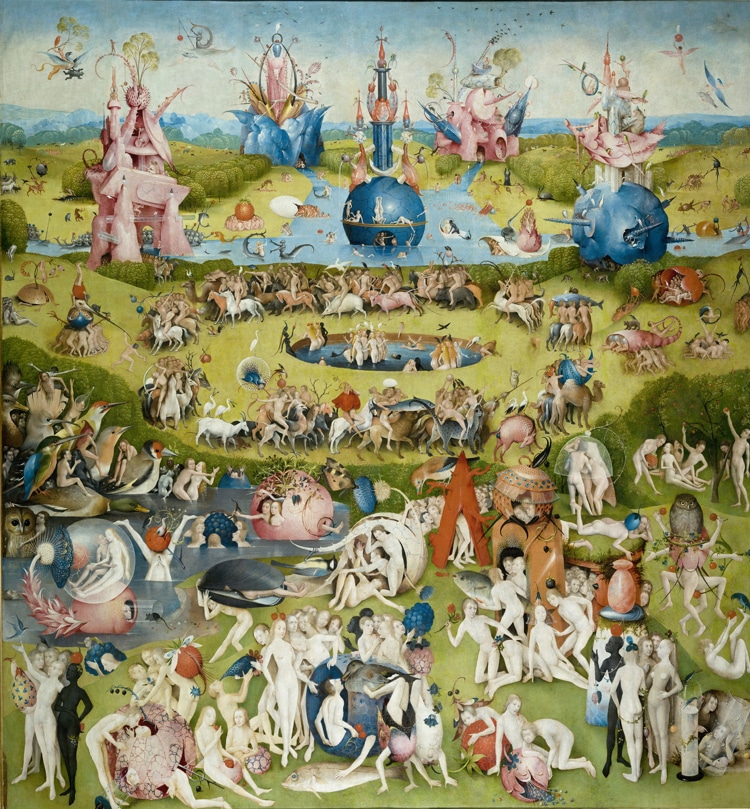
Central panel of “The Garden of Earthly Delights” (c. 1490–1510) by Hieronymus Bosch. (Photo: Public domain via Wikipedia)
This post may contain affiliate links. If you make a purchase, My Modern Met may earn an affiliate commission. Please read our disclosure for more info.
There are some artists whose work is so powerful and so recognizable that their importance in history cannot be understated. Hieronymus Bosch is one of those artists. Known for his unique vision, bizarre characters, and outlandish hellscapes, he was a leading figure in late 15th- and early 16th-century art and has had a lasting influence that’s trickled down to other artists for centuries. And if that weren’t enough, Bosch’s The Garden of Earthly Delights is one of the world’s most recognizable paintings.
Though we know very little about Bosch’s life, we do know that he grew up in a Europe that was overflowing with artistic activity. And during this time, he was a leader in Early Netherlandish painting. Not only was he a leader, but he was also a visionary artist whose depictions of religious subjects used symbols and imagery with unparalleled creativity.
Let’s take a look at what we do know about this creative genius and learn more about the time he lived in. From there, by examining his style we’ll come away with a better understanding of some of his most famous paintings and see what makes his work so revolutionary.
|
Full Name
|
Jheronimus van Aken
|
|
Born
|
between 1450 and 1456 (‘s-Hertogenbosch, Netherlands)
|
|
Died
|
buried August 9, 1516 (‘s-Hertogenbosch, Netherlands)
|
|
Notable Artwork
|
The Garden of Earthly Delights
|
|
Movement
|
Northern Renaissance
|
Who Was Hieronymus Bosch?

“St. John the Baptist in the Wilderness” (c. 1489) by Hieronymus Bosch (Photo: Public domain via Wikipedia)
Unfortunately, little is known about Bosch’s early life, as he didn’t leave behind any diaries or letters. He was born Jheronimus van Aken in the Dutch town of ‘s-Hertogenbosch, which was often called Den Bosch. This is where his famous last name comes from. It’s unclear when Bosch was born, but scholars believe it was around 1450. He was first mentioned in city records in 1474 when he was named along with his siblings. His birth year is typically estimated based on a self-portrait he drew in 1516, the year he died. In that drawing, he appears around 60 years old.
We do know that he was born into a family of artists. His grandfather Jan van Aken and father Antonius van Aken were both painters. In fact, Bosch shows up in the records of his father’s art studio as part of the workshop in 1475.
We also know that he remained close to ‘s-Hertogenbosch his whole life and, around 1480 married a woman named Aleid van der Mervenne. His bride came from a wealthy family and this helped give him enough stability so that he could open his own workshop. From there he established a successful practice and, in 1486, was mentioned in the records for the Illustrious Brotherhood of Our Blessed Lady. He not only created paintings for the important local religious confraternity, but he also designed stained glass for their chapel. By the early 1500s, records show that Bosch has studio assistants that he was able to pay for their work.
In 1516, records from the Illustrious Brotherhood mention that a large funeral was held for him in August, though the cause of death is unclear.
Early Netherlandish Art
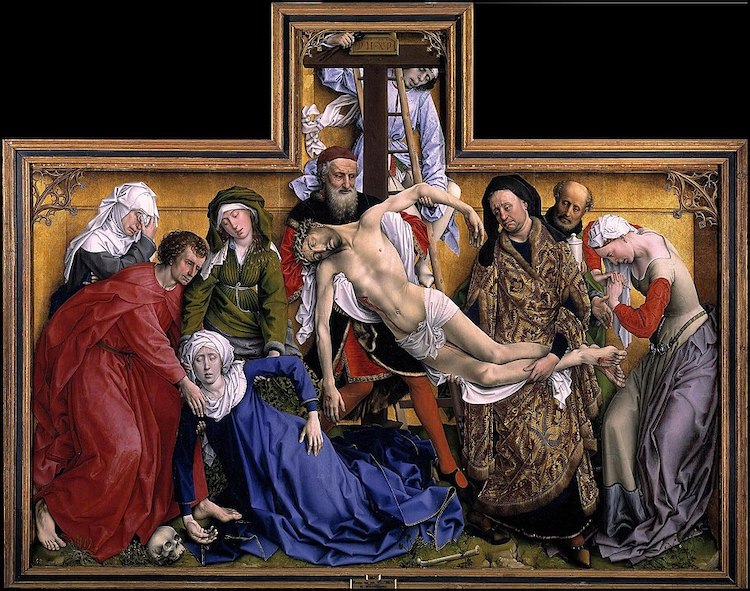
“The Descent from the Cross” (c. 1435) by Rogier van der Weyden (Photo: Public domain via Wikimedia Commons)
To get more context about Bosch’s art and understand what made it so revolutionary, it’s important to discuss the artistic environment that surrounded him. Early Netherlandish Art, or Early Flemish Art, is a period of flourishing artistry that took place in the Burgundy and Hapsburg-ruled Netherlands in the mid-15th and 16th centuries. Often referred to as the Northern Renaissance, art blossomed under the patronage of the ruling dukes. As the economy of the Low Countries exploded, money for high-paying commissions poured in.
The use of oil paint allowed these artists to create paintings with rich, layered colors. Complex iconography, genre scenes, and landscapes were all commonplace. Portable altarpieces in the form of diptychs and triptychs were quite popular, with religious painting taking a dominant position over the mythological and narrative paintings that would be more prominent in the Italian Renaissance.
Jan van Eyck, Hans Memling, and Rogier van der Weyden are some of the most famous artists of the period. And while Bosch is often mentioned alongside them as a leading artist of the day, his paintings show his independent mind. For even though he used the same medium, he executed his work in a style that was uniquely his own.
Style and Symbolism
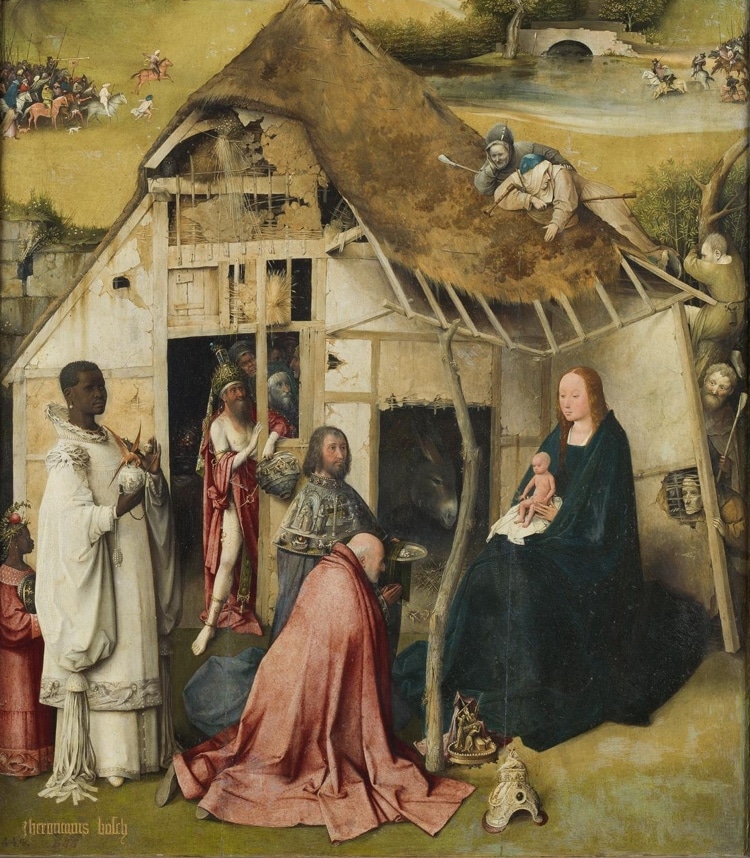
Detail of central panel of “Adoration of the Magi” (c. 1485–1500) by Hieronymus Bosch (Photo: Public domain via Wikipedia
Like his contemporaries, Bosch primarily painted on oak panels using oil paints. But his subject matter—or rather how he visually expressed his subject matter—is what separates him from the pack. Art historians have divided Bosch’s work into three periods—early (c. 1470–1485), middle (c. 1485–1500), and late (1500-1516). While his style developed over time, from his earliest works he shows his love for complex, chaotic scenes filled with grotesque characters.
Using a limited color palette dictated by the pigments available at the time, he was known for his ability to take advantage of the triptych format to create a narrative. His work was dominated by hellish scenes filled with demons, fires, and bizarre figures. He would often incorporate animals into his paintings, taking advantage of their symbolism. For instance, in his triptych Adoration of the Magi, toads are incorporated into the central panel as symbols of heresy. In The Garden of Earthly Delights, animals take center stage, often tormenting humans for their misdeeds.

“The Crowning with Thorns” (c. 1510) by Hieronymus Bosch. (Photo: Public domain via Wikipedia)
Fantasy hellscapes dominate his work. The Last Judgment, Seven Deadly Sins, and temptation are frequent themes one often finds in his paintings. The devil is a recurring figure. Art historians have spent centuries trying to interpret his work, and many have recently concluded that what was once seen as gruesome fantasy is actually a visual tool to teach a specific moral code. In this way, each figure has a precise meaning and can be seen as a metaphor for language in the Bible.
While his most famous artworks are comprised of hundreds of figures, his late paintings change dramatically in scale. The Crowning with Thorns is a good example of what his late style looked like. Here, the scale is enlarged and just a few figures are densely packed together in the foreground.
Famous Works of Art
Bosch’s oeuvre has been an interesting mystery for art historians. Because he rarely signed his paintings—and never dated them—putting together a timeline of his art is an evolving puzzle. In 2016, the Bosch Research and Conservation Project examined the oak panels used by Bosch and used dendrochronology to determine the date of execution. As dates are not exact, this is why there is often a wide range given for each completed piece.
Attribution is also an issue. This is partially due to the lack of signatures and partially due to the fact that his work was already quite popular shortly after his death. As such, well-executed copies circulated and have often been the subject of debate by scholars. Advances in technology, such as infrared scans, have allowed scholars to closely examine panels attributed to Bosch in order to see if the underpaintings are consistent with his work. Over time, fewer and fewer artworks have been confirmed to be by Bosch, with many now attributed to his followers.
But even for all these problems, there is no denying Bosch’s impact on the art world. Let’s look at two of his most famous triptychs to get better insight into his creative mind.
The Garden of Earthly Delights

‘The Garden of Earthly Delights” (c. 1490–1510) by Hieronymus Bosch. (Photo: Public domain via Wikipedia)
Undoubtedly Bosch’s most famous work, The Garden of Earthly Delights is one of the masterpieces of 15th- and 16th-century Western Art. Believed to have been painted between 1490 and 1510, this triptych is on view at Madrid’s Prado Museum. Interestingly, scholars do not think that it was used as an altarpiece and its exact meaning has been debated for centuries.
What we do know is that the left panel shows the Garden of Eden, most likely at the moment when Adam is introduced to Eve. Odd, fantastical animals already made their appearance, crawling from a hole in the foreground. The background is populated by exotic animals, including a monkey riding an elephant and a giraffe. There are many symbols alluding to sexual activity that make Bosch’s a completely unique depiction of the Garden of Eden, which is typically shown as a place of innocence.

Left and right panels. (Photo: Wikimedia Commons, Public domain)
The center panel is filled with hoards of nude figures. Some cavort and frolic with animals while others enjoy nibbling on oversize fruit. This scene is excess is filled with oddities, such as a man carrying a couple enclosed in a mussel shell on his back and a knight with a dolphin tale sailing on a winged fish. This depiction of excess pleasure has been interpreted in many ways. Some art historians believe that it shows a utopia prior to the fall of the Garden of Eden, while others think that the central panel acts as a link between the past and future of the side panels.
And while Bosch’s painting has already had its peculiarities, the right panel is where he really lets his imagination run wild. Hell is a place that he’d depicted many times before, but here he takes things to another level. In this hellscape, we perhaps see the results of the wild abandon enjoyed by the revelers in the center.

Detail of right panel. (Photo: Public domain via Wikipedia)
The humans who gave into temptation are damned to live in hell and, in Bosch’s fantasy, they are in for a difficult journey. In this panel, we see cities on fire, demons, and people being tortured by animals. A central figure of this panel has been dubbed the Tree-Man. His bloated torso is a broken eggshell supported by tree trunks. A disk on his head supports demons and their victims moving around a set of bagpipes, which is seen as a sexual symbol. In Bosch’s world, it appears that lust and sexuality have a high price and symbolize humanity’s fall from grace. This would have been consistent with morals from the Middle Ages.
The Garden of Earthly Delights is a feast for the eyes, and viewers have certainly been enthralled by both the details and Bosch’s rich imagination for centuries. Though we can’t be quite sure what it means, most evidence points to a commentary on the sins and judgment of man.
Want to learn more about Bosch’s most famous painting? We’ve got 17 facts about The Garden of Earthly Delights.
The Temptation of St. Anthony
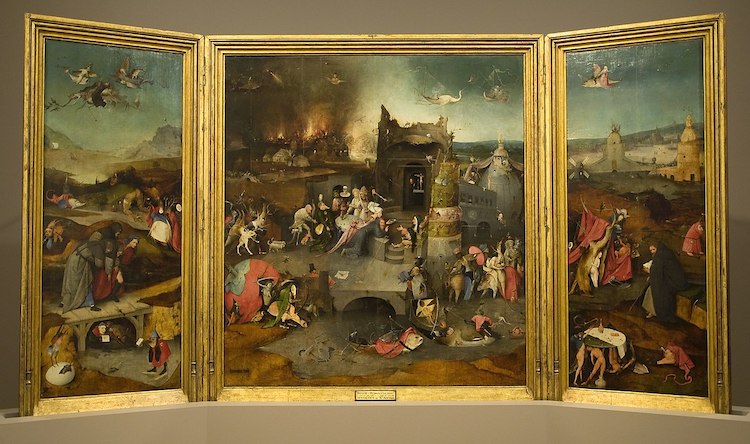
“The Temptation of St. Anthony” (c. 1500) by Hieronymus Bosch (Photo: Public domain via Wikipedia)
The Temptation of St. Anthony triptych was painted around 1501 and shows the trials and tribulations of the hermit saint, Anthony Abbot. Visual depictions of his story were common in Medieval and Renaissance art. Spending many years in the Egyptian desert as a hermit, devoting himself to prayer. The devil, angry with his decision, sent numerous temptations in order to lure him from his spiritual path.
Bosch uses his trademark symbolism and bizarre characters to bring a visual to Anthony’s anguish. In the central panel, the saint can be seen kneeling in the center. Around him swirl various temptations, but he steadfastly looks toward his cell, which contains a miniature Christ and a crucifix. There are several demonic groups in the panel that include depictions of the devil. In one instance, the devil is playing the harp, while in another it’s riding a chicken.
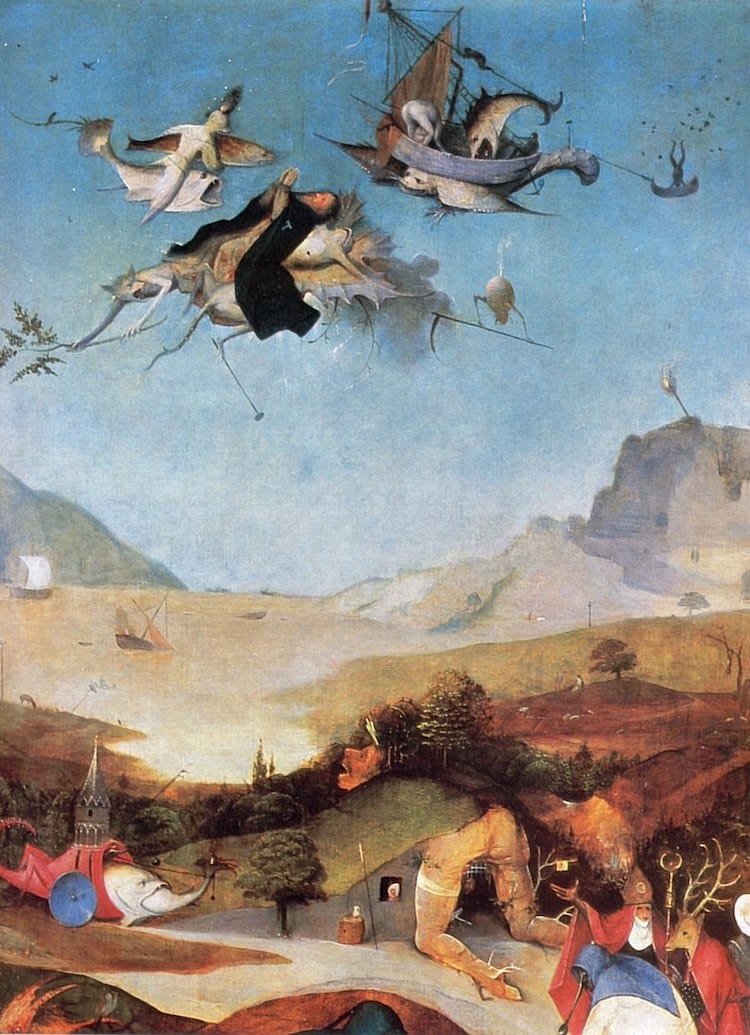
Detail of right panel. (Photo: Public domain via Wikipedia)
The right panel shows the flight and fall of St. Anthony. Here, we see the saint being carried through the sky by a pack of demons. Down below, a weary St. Anthony is helped by two monks and a layman. The layman has traditionally been identified as Bosch himself. In the left panel, we see Bosch’s version of The Contemplation of St. Anthony. The hermit is being tempted by a naked woman who appears from within a hollow tree, while a table of food in the foreground provides another type of test. The saint is seen in contemplation at the center.
The exterior panels of the triptych, only seen when it was shut, are also quite interesting. As Bosch often did with these panels, they are painted in grisaille—or shades of grey and white. Altarpieces of this nature would have been closed in the week leading up to Easter, and so Bosch appropriately chose to depict the Arrest of Christ and Christ Carrying the Cross.
Bosch’s portrayal of the story was quite popular and spurred numerous copies, many of which still exist.

Closed triptych (Photo: Public domain via Wikipedia)
Legacy
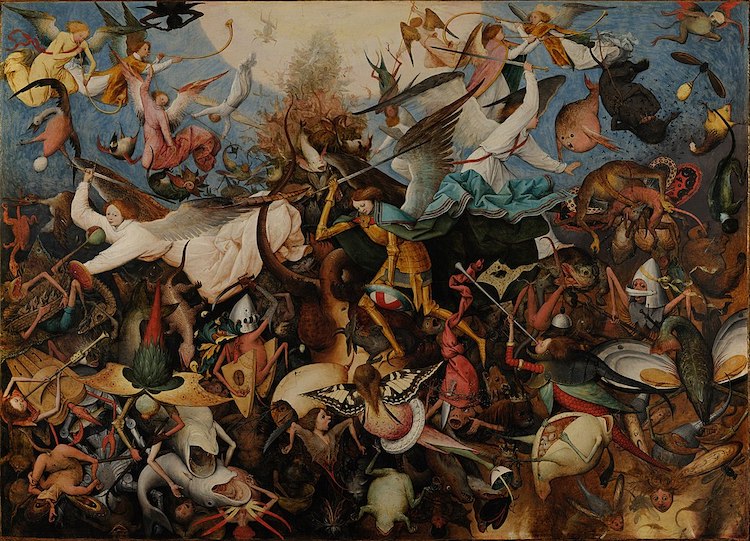
“The Fall of the Rebel Angels” (1562) by Pieter Bruegel. (Photo: Public Domain via Wikimedia Commons)
Bosch’s most immediate impact can be seen in the work of 16th-century Flemish painter Pieter Bruegel, his most well-known follower. Bruegel’s depictions of peasant life often contained grotesque characters clearly influenced by Bosch’s fantastical paintings.
Much later, in the 20th century, his work would become a favorite among the Surrealists. The group’s love for dreamscapes and push for an unconscious, free-flowing imagination made Bosch’s paintings particularly appealing. In particular, Bosch’s influence can be seen in the work of Salvador Dalí, who would have seen The Garden of Earthly Delights at the Prado Museum. Dalí’s The Great Masturbator even includes imagery similar to what is found on the left panel of Bosch’s famous triptych. Joan Miró and Rene Magritte are among the other Surrealists who had a deep appreciation for his work and incorporated elements of his iconography into their own paintings.
Books About Hieronymus Bosch
Want to expand your knowledge about Hieronymus Bosch? Check out some of these books. (Making a purchase via Bookshop helps support independent bookstores.)
Frequently Asked Questions
Why is Hieronymus Bosch important?
Bosch is considered an important artist of the Northern Renaissance or Early Netherlandish painting. His artwork has been very influential, particularly with the Surrealists, for his use of fantastical creatures and demons.
How many Bosch paintings are there?
Only about 25 paintings have been solidly attributed to Bosch, as he signed very few of his pieces and dated none of them.
Where is The Garden of Earthly Delights located?
Bosch’s most famous artwork is part of the Prado Museum’s collection. Located in Madrid, Spain, the museum has housed the artwork since 1939. The painting has been in Spain for over 400 years, as King Philip II of Spain was a collector of Bosch’s work.
Related Articles:
13 of Art History’s Most Horrifying Masterpieces
9 Famous Renaissance Artists Whose Work Transformed the Art World
Who Was Albrecht Dürer? Learn About the Pioneering Northern Renaissance Printmaker
Learn the Intriguing (and Sometimes Controversial) History Behind Michelangelo’s ‘Last Judgment’
